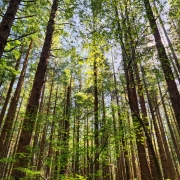Ice-Fueled Evolution
July 14, 2016 | Emily Percival-Paterson
As recently as 10,000 years ago this land was covered in ice. The ice sheet stretched from coast to coast of North America. Along Vancouver Island it was up to 2km thick: covering everything except for a few of the highest peaks. This created a frozen desert few things could survive. Like modern times, while the rest of northern North America struggled under frozen conditions, life flourished in paradise on the west coast.
As the oceans froze, water levels dropped to expose the continental shelf. As the ice sheet covered the land animals were forced to move out onto the shelf in order to survive. As the ice advanced further and further, coastal animals were trapped into an area now referred to as the “Continental Shelf Refugia” which stretched from Vancouver Island northward to Haida Gwaii.
For the duration of the ice age, which could have been up to 150,000 years, plants, insects, mammals, birds and fish lived in this area off the west coast. This isolation created a small evolving population that rapidly became coastal experts.
Fish such as the three spined stickleback evolved to keep or get rid of their spines depending on which predators were present in their lakes. Black bears evolved to have bigger skulls and bigger molars to help them crunch on food they found under rocks in the intertidal zone. Some owls developed darker feathers to help them blend into forests full of darker-leafed trees. Some ground beetles evolved different body shapes to help them live in washed up driftwood.
With recent advances in technology, scientists on the coast are analyzing mitochondrial DNA of coastal animals and interior animals to compare them for differences, which would indicate that they had been separated at some point. So far they’ve found out the following animals are distinct versions compared to their mainland counter parts: black bears (Ursus americanus), wolves (Canis lupus), martens (Martes caurina), rock ptarmigan (Lagopus mutus), three spined stickleback (Gasterosues aculeatus), saw-whet owl (Aegolius acadicus), and Dawson’s caribou (Caribou dawsoni).
By looking at the DNA sequence of the same genes in both the coastal animals and the interior animals, scientists can see how many differences there are. It’s similar to how most Canadians use the spelling colour and many Americans use the spelling color. The more differences in the sequences the longer those populations have been apart, and what scientists are finding is that it’s much longer than 10,000 years, which means coastal animals must have survived during the ice age on some sort of refugia.
Once the ice started to melt, the oceans started to rise again and the animals of the Continental Shelf Refugia spread to repopulate the islands and the coast of the mainland. So the next time you see a bear turning over rocks along the shore, or a wolf swimming between islands, keep in mind animals on our coast have been making it their home for over 10,000 years and have become specialists to survive here. That also means that this is the only place they know, so please make sure that while you’re enjoying their home be considerate: keep our animals wild and alive.



